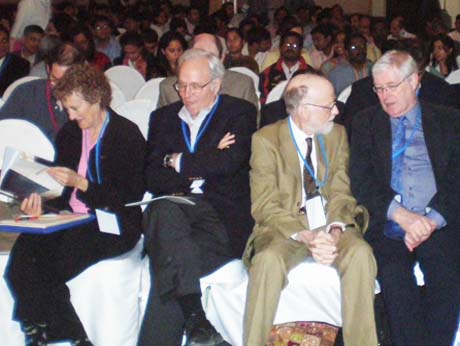
The co author of the RSA alogorithm, one of the most widely used encryption tools on the Internet.
The pioneer of data abstraction – the technique that is fundamental to the development of all computer programming languages.
The man who developed the world’s most widely used sorting algorithm – Quicksort – and went to co-create the first compiler for the Algol programming language.
The developer of the world’s working personal computer, the Xerox Alto and the first three-button mouse that went with it.
All four them honoured with the A.M. Turing Award*, considered to the 'Nobel Prize' of computer sciences. And all of them speaking in the same session of computer conference to an audience of over 1000 students and young programmers? Can this ever happen? It can and it did – in Bangalore, today, January 22 at the annual Research Symposium, TechVista of Microsoft Research in India.
Dr Adi Shamir ( the ‘S’ in RSA) of the Weizman Institute, kept the audience enraptured by demonstrated many of the toughest crypto codes he himself had developed for RSA could be cracked in milliseconds – using such esoteric techniques like freezing a PC’s memory with liquid oxygen so that its last logged encryption code can be hacked, or listening to the ‘noise’ made by the CPU card to tell you ‘acoustically, what is stored in it.
Prof Barbara Liskow, of MIT, whom we featured in this space yesterday, http://www.indiatechonline.com/barbara-liskov-on-computational-cloud-197.php warned of a future where robotics might become so advanced as to enable war to be unleashed where the aggressor suffers no human cost.
Sir Charles “Tony” Hoare who followed up Quicksort, with Hoare Logic, the formal language for sequential processing, suggested that tomorrow’s computers might turn to Sanskrit grammarian Panini, to advance the science of machine translation.
Dr Butler Lampson whose vision of a personal computer while at Xerox Parc, predated both the Apple and the IBM PC, suggested that the Next Wave of computing would be what he called “Embodiment” -- cyber physical systems that are available as vacuum cleaner robots for the home today but might end up as self driving cars 25 years from now.
Steering the discussion was another Tony – Hey – who heads External Research at Microsoft and is an authority on parallel programming for supercomputers and the co author of a message passing standard, MPI. “I’m scared computers will not allow me to forget anything in the future”, he said, warning that privacy issues will loom large in the future.
The conference marked 5 years of Microsoft Research’s India Centre in Bangalore. Managing Director MSR India, Dr P Anandan committed the Centre to continued excellence in seven areas including algorithms, cryptography, multi language systems, mobility, and ICT for emerging markets. It was inaugurated by Nandan Nilekani, Chairman of the Unique Identification Authority of India, who in his opening remarks sought the computer community’s help in addressing some of the challenges facing his new mandate from government – like creating the world’s largest biometric database of a billion plus records – and updating nearly a million records, every night, while performing de-duplication. Rick Rashid, Microsoft's Senior Vice President, Research, outlined MSR's contributions across its 6 global centres.
MSR India link: http://research.microsoft.com/en-us/labs/india/
TechVista 2010 link: http://research.microsoft.com/en-us/events/techvista2010/default.aspx
* The A.M. Turing Award of the Association of computing Machinery (ACM) is named after Alan M. Turing, the British mathematician who and who was a key contributor to the Allied cryptanalysis of the German Enigma cipher during World War II.
Jan 22 2010